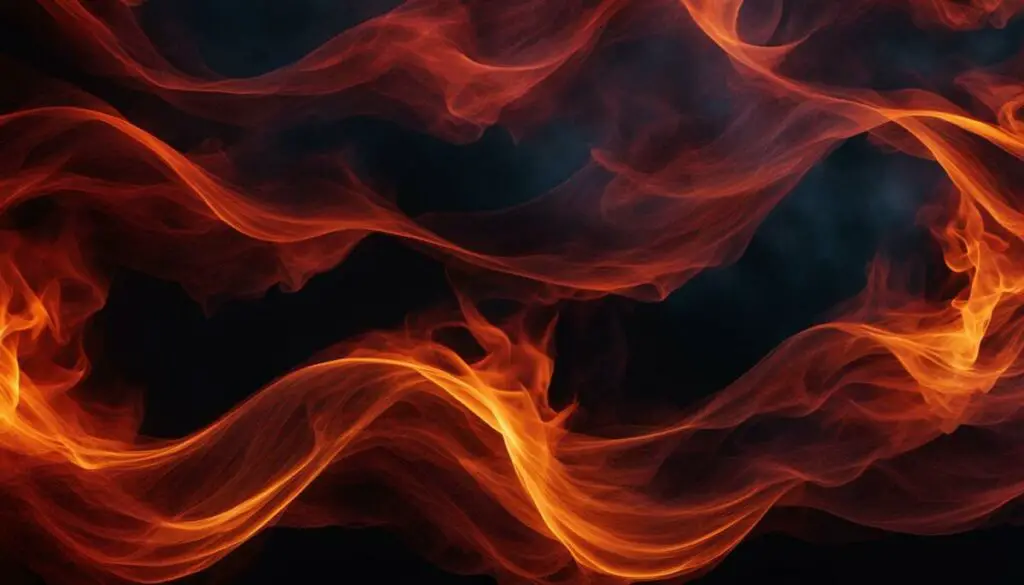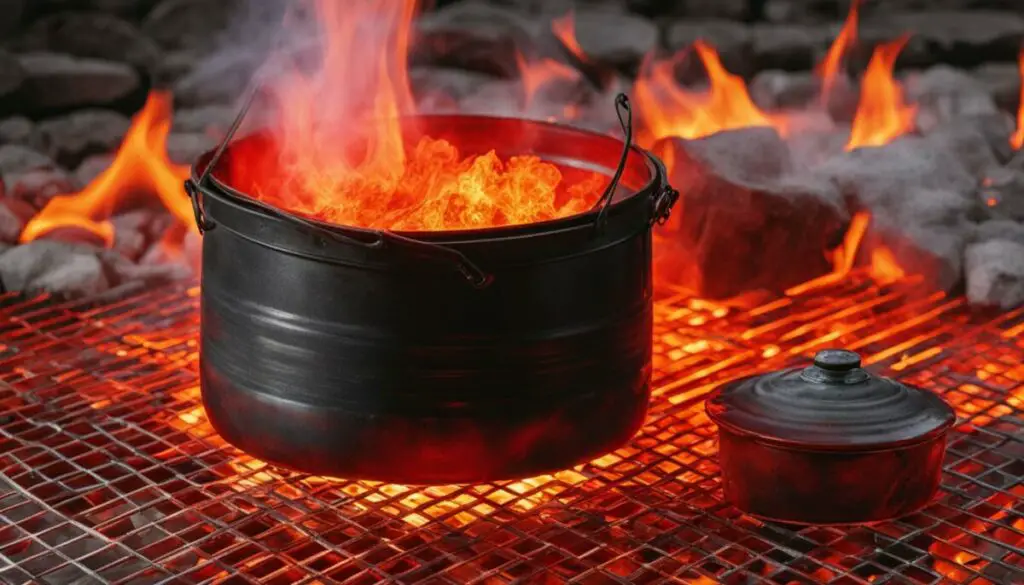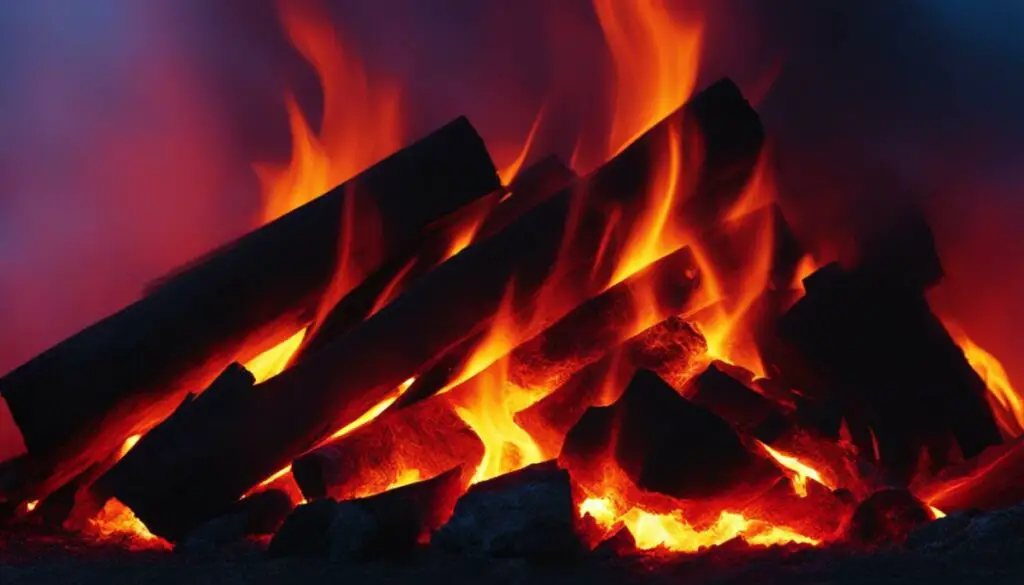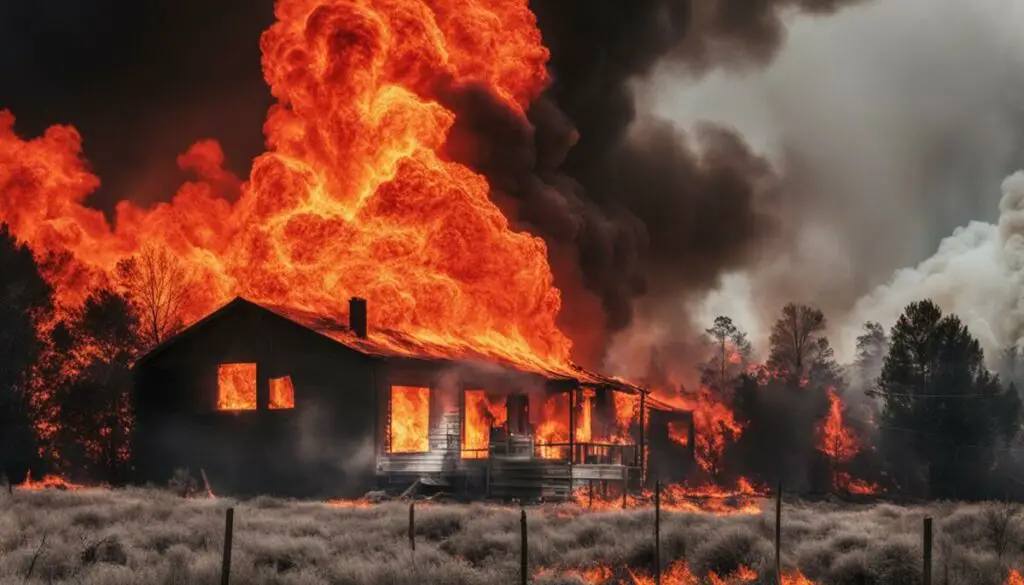Last Updated on 6 months by Francis
Fire is a fascinating element that has been studied for centuries. From its mesmerizing flames to its ability to generate heat, fire has captivated scientists and the general public alike. One question that has emerged in recent years is whether fire produces infrared radiation. In this section, we will explore the relationship between fire and infrared radiation and uncover the truth.
Contents
Key Takeaways
- There has been debate around the question of whether fire produces infrared radiation.
- In this section, we will explore the science behind fire and heat and examine whether fire indeed produces infrared.
- The understanding of this relationship between fire and infrared has various practical applications, from thermography to fire detection.
The Science Behind Fire

Fire is a fascinating phenomenon that has captured human curiosity for centuries. But what exactly is fire, and how does it produce heat?
At its core, fire is a chemical reaction that involves the rapid oxidation of a fuel source in the presence of oxygen and heat. This process produces a release of energy in the form of heat and light, which is what we perceive as fire.
The heat generated during the combustion process is what drives many of the everyday uses of fire, from cooking food to generating electricity in power plants. The energy released by the combustion process can be harnessed and converted into heat or other useful forms of energy.
Stages of Combustion
There are three main stages of combustion: ignition, flaming combustion, and smoldering combustion.
Ignition is the initial stage where heat is applied to a fuel source, causing it to reach its ignition temperature and release vapors that can be ignited.
Flaming combustion is the stage where the fire is burning brightly and releasing heat and light. This is the stage that most people associate with fire.
Smoldering combustion is the stage where the fire is burning slowly without a visible flame. This can occur when the combustion process isn’t getting enough oxygen to sustain a flame.
Energy Transformations
During the combustion process, energy is transformed from one form to another. The chemical energy stored in the fuel is converted into heat and light energy.
Heat energy is a form of energy that causes a transfer of thermal energy from one object to another. This is the energy that we feel when we stand close to a fire.
Light energy is a form of electromagnetic radiation that we can see with our eyes. The light produced by fire is what gives it its distinctive glow.
Fire and Infrared Production
Now that we understand the fundamental principles of fire and how it generates heat, we can explore whether fire produces infrared radiation. In the next section, we will delve into the properties of infrared radiation and how it interacts with matter.
“Fire is a chemical reaction that involves the rapid oxidation of a fuel source in the presence of oxygen and heat. This process produces a release of energy in the form of heat and light, which is what we perceive as fire.”
Understanding Infrared Radiation
Infrared radiation is a form of electromagnetic radiation that has a longer wavelength than visible light. It exists in the spectrum between microwaves and visible light, with a wavelength range between 700 nanometers and 1 millimeter. Infrared radiation can be emitted by any object, including fire.
The frequency of infrared radiation is directly related to the temperature of the object emitting it. This is known as Wien’s law, which states that the wavelength of the peak radiation emitted by a body is inversely proportional to its temperature. As an object’s temperature increases, the frequency of the emitted radiation shifts toward the visible end of the spectrum.
Infrared radiation interacts with matter in several ways. It can be absorbed by certain materials, reflected or transmitted through others, or scattered in random directions. When it is absorbed, it causes the molecules of the material to vibrate, which generates heat. This process is known as thermal radiation and is the primary way that infrared radiation heats objects.
When it comes to fire, it is important to consider the type of flame. Visible flames are the result of combustion reactions that produce light, heat, and gas. These flames emit a significant amount of infrared radiation, but not as much as non-visible flames. Non-visible flames are hotter and emit much more infrared radiation than visible flames. Most fires, particularly those in enclosed spaces, will produce both visible and non-visible flames, making them significant sources of infrared radiation.
Fire as a Source of Infrared

Now that we have established a basic understanding of both fire and infrared radiation, we can explore whether fire indeed produces infrared. The answer is yes, fire generates infrared radiation.
As a combustion reaction occurs, energy transformations take place, and the heat generated causes the emission of various wavelengths of electromagnetic radiation, including infrared. In other words, the heat energy produced during combustion is responsible for the emission of infrared radiation.
To better understand the mechanisms by which fire produces infrared, we can examine the combustion process further. During the process of combustion, a fuel source reacts with an oxidant, typically oxygen, in the presence of heat, leading to the production of energy and various products, including carbon dioxide, water, and soot.
During the process, the high temperature resulting from the exothermic reaction causes the electrons in the atoms and molecules of the combustion products to become excited and emit electromagnetic radiation, including infrared. The intensity and wavelength of the radiation emitted depend on several factors, including the temperature, fuel type, and combustion process conditions.
| Factors Influencing Infrared Production from Fire | Effects on Infrared Emission |
|---|---|
| Fuel Type | Different fuels emit different levels of infrared radiation due to their unique chemical composition |
| Temperature | The higher the temperature of the fire, the greater the intensity of infrared radiation emitted. |
| Combustion Process Conditions | The presence of soot or other impurities can affect the amount and wavelength of infrared radiation emitted from a fire. |
In summary, fire is indeed a source of infrared radiation. The heat generated during the combustion process causes the emission of various wavelengths of electromagnetic radiation, including infrared. The amount and wavelength of the radiation emitted depends on several factors related to the fuel source, temperature, and combustion process conditions.
The Relationship Between Fire and Infrared

Now that we understand the basics of how fire produces infrared radiation and the properties of infrared, let’s explore the relationship between the two. As we’ve previously mentioned, fire is one of the main sources of infrared radiation in our environment.
As the temperature of the fire increases, so does the amount and intensity of the infrared radiation emitted. This means that hotter fires will produce more infrared radiation than cooler ones. In addition, the type of fuel burning in the fire can also affect the amount of infrared radiation produced.
It’s important to note that not all of the energy released by a fire is in the form of infrared radiation. In fact, only a small percentage of the energy released by fire is emitted as infrared radiation. Nonetheless, this small percentage has significant practical applications in a range of fields.
One of the key applications of this relationship is in the field of thermography. Infrared cameras are used to capture images of infrared radiation emitted by objects, including fires. These images can then be used to identify hot spots, temperature variations, and potential fire hazards.
The relationship between fire and infrared radiation also has applications in infrared spectroscopy, which is used to analyze the chemical composition of materials. In this process, infrared radiation is used to identify the unique molecular vibrations of different substances.
Overall, the relationship between fire and infrared is a fascinating topic with numerous practical applications. By understanding this relationship, we can gain valuable insights into the behavior of fires and utilize infrared radiation in various fields.
Infrared Production by Flames

Flames play a critical role in the production of infrared radiation from fire. The heat generated from flames is responsible for exciting molecules in the surrounding gases, leading to the emission of infrared radiation.
Combustion reactions occurring within the flames contribute significantly to the production of infrared radiation. As fuel burns, it releases energy that is then converted to heat, which ultimately leads to the emission of infrared radiation. Flames with higher temperatures generally produce more infrared radiation than those with lower temperatures.
Moreover, the characteristics of flames also affect their infrared emission. Flames with a higher concentration of hydrocarbons typically produce more infrared radiation than those with a lower concentration. This is due to the fact that hydrocarbons absorb and emit infrared radiation more efficiently than other gases present in the flames.
| Factors Affecting Infrared Emission | Explanation |
|---|---|
| Fuel Type | The type of fuel used affects the concentration of hydrocarbons in the flames and, therefore, the amount of infrared radiation emitted. |
| Temperature | The higher the temperature of the flames, the more infrared radiation is emitted. |
| Flame Conditions | The concentration of hydrocarbons and other gases in the flames affects their ability to absorb and emit infrared radiation. |
Understanding the factors that influence the production of infrared radiation from fire is critical in various fields, including fire detection and industrial applications. By examining the characteristics of flames and the combustion reactions that occur within them, we can better understand and utilize the infrared radiation produced by fire.
Factors Affecting Infrared Emission from Fire

While flames play a significant role in the production of infrared radiation from fire, there are several other factors that can impact the amount of infrared emitted. Here are some of the key factors:
- Fuel type: The type of material that is burning can have a significant impact on the amount of infrared radiation emitted. Different materials have different emissivity values, which determine how much infrared energy is released. For example, wood and plastics tend to have high emissivity values, which means they emit more infrared radiation than metals or glass.
- Temperature: The temperature of the fire is another important factor. Higher temperatures lead to greater infrared radiation emission, as the atoms and molecules in the flames vibrate more rapidly and produce more energy in the form of radiation.
- Flame conditions: The conditions within the flame itself can also impact the amount of infrared radiation emitted. For example, flames with more oxygen tend to burn at higher temperatures and emit more infrared radiation. Additionally, the length and shape of the flame can also affect infrared production.
Understanding the factors that influence infrared emission from fire can be useful in various applications, such as fire detection and thermal imaging. By controlling these factors, it may be possible to manipulate the amount and properties of the infrared radiation produced.
“Different materials have different emissivity values, which determine how much infrared energy is released.”
Infrared Radiation from Fire: Its Practical Applications

Infrared radiation emitted by fire has a wide range of practical applications, making it a vital aspect of scientific research and industry. In this section, we will explore how fire’s infrared radiation is utilized in various fields.
- Thermography: Infrared cameras are used in thermography to detect heat patterns in various objects and materials. These cameras can capture infrared radiation emitted by fire, and the data can be analyzed to identify hotspots and temperature variations.
- Infrared Spectroscopy: The study of infrared spectra generated by fire and other sources is crucial in various scientific fields, including chemistry and physics. Infrared radiation is used to identify the composition of materials, including gases and liquids.
- Fire Detection: Infrared detectors are utilized in fire detection systems as they can detect the presence of infrared radiation emitted by fire. These systems can sound an alarm or alert authorities to potential fires even before smoke or flames become visible.
These applications are just a few examples of how infrared radiation emitted by fire is utilized in today’s world. As technology continues to advance, it is likely that we will discover new ways to utilize this valuable resource.
Safety Considerations and Fire Hazards

While infrared radiation from fire has various applications, it is essential to be aware of the potential hazards associated with it.
The primary concern is the risk of burns from exposure to infrared radiation. The heat generated by the fire can cause severe skin and eye injuries, so it is crucial to maintain a safe distance from the flames.
Additionally, infrared radiation can also pose a fire hazard. High-intensity infrared radiation can ignite combustible materials, leading to a fire. As such, it is vital to conduct proper risk assessments before using any equipment that produces infrared radiation to prevent fires.
When dealing with fires that emit infrared radiation, it is essential to wear protective gear such as heat-resistant clothing, gloves, and safety goggles.
It is also crucial to ensure that any infrared equipment used is adequately maintained and that the manufacturer’s instructions are followed to avoid any accidents resulting from malfunctioning equipment.
In summary, while infrared radiation from fire has many practical applications, it is essential to be aware of the potential risks and take appropriate precautions to ensure safety.
Advancements in Infrared Technology
The understanding of the relationship between fire and infrared radiation has led to various advancements in technology. Infrared imaging has proved to be a valuable tool in multiple areas of study. With modern equipment, we can detect and analyze infrared radiation from fire in ways that were impossible before. These advancements have major implications, from enhancing scientific research to improving safety and security.
Infrared Imaging
Infrared cameras have become increasingly popular in various fields, including medicine, biology, and physics. They work by detecting the infrared radiation emitted by objects and visualizing them as an image. This technology allows researchers to study phenomena that would otherwise be difficult or impossible to observe. For example, in biology, infrared imaging can be used to observe the behavior of animals and insects in the dark, as they emit infrared radiation. Similarly, in medicine, infrared cameras can detect temperature changes in the body, aiding in diagnosis and treatment.
Infrared Spectroscopy
Infrared spectroscopy is another technique that has benefitted from our understanding of fire and infrared radiation. It involves analyzing the way that materials interact with infrared radiation. By studying the properties of light absorbed or reflected by a material, we can learn about its molecular composition. This technique has applications in fields such as chemistry, geology, and even art history. In chemistry, infrared spectroscopy is used to identify the composition of substances, while in art history, it has been used to determine the authenticity of paintings.
Fire Detection
The relationship between fire and infrared radiation has also led to the development of advanced fire detection systems. Infrared sensors can detect the infrared radiation emitted by fires, even at early stages when other forms of detection may fail. This technology has been instrumental in preventing fires and minimizing damage in a variety of settings, from homes to factories.
Conclusion
After exploring the science behind fire and infrared radiation, it’s clear that fire does indeed produce infrared. This relationship between fire and infrared is crucial in various fields, including thermography, fire detection, and infrared analysis. It is fascinating to see how advancements in infrared technology have allowed us to better understand and utilize the infrared radiation produced by fire.
However, it is also essential to consider the safety implications of being exposed to infrared radiation from fire. Precautions should be taken to reduce potential hazards associated with infrared exposure.
In conclusion, the question of “Does fire produce infrared?” can be confidently answered with a resounding “yes.” The understanding of this relationship between fire and infrared contributes to our knowledge of the natural world and its practical applications.
FAQ
Does fire produce infrared?
Yes, fire produces infrared radiation as a byproduct of its combustion process.
What is the science behind fire?
Fire is a rapid oxidation process that releases energy in the form of heat and light. It involves the chemical reaction between a fuel source, oxygen, and heat.
What is infrared radiation?
Infrared radiation is a type of electromagnetic radiation with wavelengths longer than those of visible light. It is invisible to the human eye but can be detected by specialized devices.
How does fire generate infrared radiation?
Fire produces infrared radiation through the heating of objects and gases in its surroundings. The high temperature of the flames and hot materials emit infrared waves.
What is the relationship between fire and infrared?
Fire and infrared are closely connected as fire is one of the primary sources of infrared radiation in our environment.
How do flames contribute to infrared production?
Flames play a significant role in the production of infrared radiation. The combustion reactions within flames generate heat, causing the emission of infrared waves.
What factors affect the amount of infrared radiation emitted by a fire?
Factors such as the temperature of the fire, fuel type, and flame conditions can influence the amount of infrared radiation emitted.
What are the applications of infrared radiation from fire?
Infrared radiation emitted by fire has various applications, including thermography, infrared spectroscopy, and fire detection systems.
Yes, it is important to exercise caution when dealing with fires and infrared radiation exposure. Protective measures should be taken to prevent harm.
What advancements have been made in infrared technology?
Infrared technology has advanced, allowing for better understanding and utilization of infrared radiation from fire. Modern tools and techniques aid in infrared imaging and analysis.









